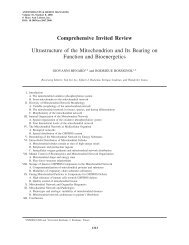MiPsummer Programme pdf - Mitochondrial Physiology Society
MiPsummer Programme pdf - Mitochondrial Physiology Society
MiPsummer Programme pdf - Mitochondrial Physiology Society
Create successful ePaper yourself
Turn your PDF publications into a flip-book with our unique Google optimized e-Paper software.
75<br />
Abstract # 43<br />
Metabolic flexibility before and after lifestyle intervention in a diet-induced type 2 diabetes<br />
animal model<br />
Gonzalez-Franquesa, A 1 . Martinez-Navarro 1 , L. Fernandez-Ruiz, R 2 . Garcia-Roves, PM 1,2 .<br />
1 Diabetes and Obesity Laboratory, August Pi i Sunyer Biomedical Research Institute (IDIBAPS),<br />
Barcelona, Spain. 2 Spanish Biomedical Research Centre in Diabetes and Associated Metabolic<br />
Disorders (CIBERDEM).<br />
Background<br />
Sedentary habits along with an excess of macronutrients intake are spreading obesity-related type 2<br />
diabetes hence, becoming an epidemic global problem. Metabolic flexibility (1) is defined by Kelley<br />
et al. as the “clear capacity to utilize lipid and carbohydrate fuels and to transition between them”.<br />
The disruption of this ability, the so-called “metabolic inflexibility”, could play an important role<br />
during the early onset of type 2 diabetes when there is already evidence of fasting hyperinsulinemia,<br />
hyperglycemia and hyperleptinemia.<br />
Objective<br />
The aim of this project is to assess the metabolic adaptations on an animal model of diet-induced<br />
type II diabetes and the effect of a lifestyle intervention programme in reverting them.<br />
Methods<br />
C57BL/6J male mice were used for the study and divided in three groups: a control (Ctrl) group<br />
(fed for 16 weeks with chow standard diet), a high fat diet (HFD-pathological) group (fed for 16<br />
weeks with 45% HFD) and an intervention (Int) group (in which a lifestyle intervention was<br />
performed after feeding the animals with 45% HFD for 16 weeks). This lifestyle intervention<br />
consisted of calorie restriction, modification of the 45% HFD with mono- and poly-unsaturated<br />
fatty acids, and exercise training for 5 weeks.<br />
Results<br />
The mice in the HFD-pathological group were glucose intolerant and had disrupted insulin<br />
sensitivity when compared with their littermates, Ctrl group. Those HFD-pathological mice were<br />
overweight and hyperinsulinemic and hyperleptinemic after overnight fasting. Morphological<br />
analyses of the pancreas showed that the HFD-pathological mice had more and bigger pancreatic<br />
islets than the Ctrl littermate mice. Isolated islets from HFD-pathological mice had an increased in<br />
vitro glucose-stimulated insulin secretion. When the lifestyle intervention was performed in the<br />
HFD-pathological mice, the Int group mice reversed most of the phenotype previously defined for<br />
the HFD-pathological group mice and showed a general improvement in glucose homeostasis; thus,<br />
reversing the deleterious effects that led them to a type II diabetic-like state. This communication<br />
will be presenting how mitochondrial function will be responding to the different experimental<br />
conditions. <strong>Mitochondrial</strong> function is being evaluated in liver, hypothalamus, glycolytic and<br />
oxidative skeletal muscle, and white and brown adipose tissue.<br />
Conclusion<br />
At this point of the study, we have defined the phenotype of the three experimental groups;<br />
demonstrated that our lifestyle intervention is able to re-establish glucose homeostasis and body<br />
composition; and finally, performed mitochondrial function studies in key metabolic tissues.<br />
References<br />
(1)<br />
Storlien L, Oakes ND, Kelley DE. Metabolic flexibility. Proc Nutr Soc. 2004;63(2):363-8.



